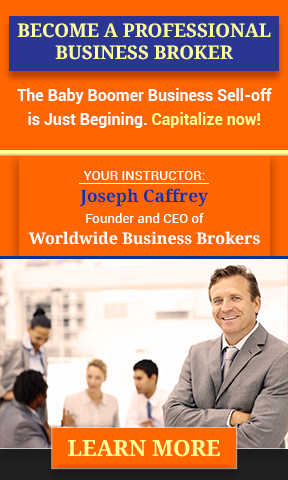Prepare Your Sellers from Joe Caffrey on Vimeo.
Prepare Your Clients – to Prepare Their Business!
 As a business broker, you MUST prepare your clients for the process of selling their business.
As a business broker, you MUST prepare your clients for the process of selling their business.
I’ve done a number of posts and podcasts meant to help business owners get their businesses ready for sale. But if you plan to become a business broker, not only do you need to guide your clients through the selling process but if they are to realize the highest value for their business and be able to sell in the least amount of time, you must advise them on preparing their business for sale.
Without the proper preparation, unless your client is so eager to walk away that the price he or she is willing to accept is significantly less than what the business is worth, you will spend more time than necessary defending your numbers and the journey from listing to sale is likely to be long and bumpy.
Some of the issues a business owner must address are small and seemingly unimportant. Others, of course, are significant. Both are important. And though you might think that these pertain more to Middle Market businesses, sellers of Main Street businesses would be wise to address them as well.
Here are a few of the issues any professional broker would coach their clients on to make sure that, when the business comes to market, it’s looking as good as possible.
Paperwork and Documentation
With the exception of the smallest businesses, the first thing any buyer is likely to see is the paperwork. If you’ enrolled in our upcoming course, The “How To” of Becoming a Business Broker, you’ll learn that this means the Abstract that you prepared describing the opportunity. You’ll also know that an Abstract is a distillation of the comprehensive data-dump that is the Offering Memorandum. And you’ll also know that, in order to prepare the Offering Memorandum, you have to have an enormous amount of information from the seller.
- Three years of profit and loss statements (P&Ls)
- Three years of tax returns.
- A list of assets and an estimate of their current market value; not cost.
- A list of liabilities.
- An abstract and copies of all leases and contracts.
- Employee details including pay rates, benefits, bonuses and whether they are contract or “at will”
- An abstract and copies of all supplier agreements.
- An abstract and copies of all client and customer agreements.
Organizing all this is generally a pain in the patootie for the seller but it has to be done. Once you have this stuff in hand, creating the Offering Memorandum – and, subsequently, the Abstract – will be easy. And getting buyers comfortable with what you’re presenting will be much smoother.
The Statistics
Make sure your client knows his s***!
A buyer is going to have a ton of questions and you and your client must, within reason, how the answers at hand. Here are a few of the basic ones you can expect.
- Why is the seller selling?
- How hard is it to get – and keep – good employees?
- What is the most profitable aspect of the business?
- What is the least profitable?
- What would the seller do over the next two years if he or she was not selling? (The seller surely has told you. If the buyer doesn’t ask, volunteer this information.)
- What is the most challenging aspect of owning this business. (Be ready to relate the most rewarding, as well!)
Learn how to value and sell businesses….
The Staff
As many of them do every day, your client’s employees represent the business and they will immediately give an impression – good or bad – to a buyer. How employees look, act and sound depends on the business and industry of course, but you want to make sure that they a looking “professional” for the profession you’re client’s business is in.
If you’re selling a small manufacturer of surf boards, T-shirts and flip flops may not be out of place – though foul language offensive or political wall art might be off-putting to a buyer. If you’re selling an automobile dealership, a business that must constantly focus on presenting itself at the highest standards of professionalism, some knucklehead in the parts department may have been permitted to waltz in in shorts and flip flops on occasion. You can’t let that happen when a buyer comes to tour.
Even within an industry, how different businesses are perceived by the general public or a buyer may differ. For example, if you’re client’s business is a way-hip restaurant serving avant-garde dishes, radical drinks and craft beers, black T-shirts, abundant skin and copious tattoos might be appropriate. In a more upscale establishment, perhaps not.
If the staff is aware that the business is for sale (not something we recommend as you can see here), they should be alerted to the buyer’s visit and be prepared to answer questions about their role in day-to-day operations.
The Real Estate

Assuming your client is selling a business that occupies physical space (as the vast majority does), after analyzing the documentation you provide, the buyer’s first impression of the business is going to be formed during the initial tour.
I did an early podcast episode on this topic and it is still pertinent to brokers and their sellers today. A buyer’s impression of the business is first formed when analyzing the numbers. But the lasting impression is formed when they pull into the parking lot and walk through the premises. If the joint is a mess, will a buyer want to see himself as the owner? Will he wonder if his wife and kids will be proud of their dad’s business?
These questions cross the minds of buyers and sellers – and their brokers – must be mindful to present the business in the best possible light.
Here are two examples of businesses that we listed years ago that exemplify the importance of the visual.
One was a 150-unit mobile home park. The place was a mess. Trash, derelict cars, trailers with missing skirts, old campers, overgrown bushes and knee-high grass, derelict residents, etc. Debris was everywhere; the place was a shambles. We sold it but the group of buyers was narrowed down to those that knew they were getting the proverbial “fixer-upper” – and the price they offered reflected that. For this business we had fewer buyers and a lower sale price.
At the other end of the spectrum was a business that one would associate with messy operations. This was a $4 million bait distributor. They took in all sorts of messy baits in bulk, repackaged it and branded it then distributed the stuff. Fish guts, chicken necks, worms and God-knows-what-else.
As you can imagine, the operation was messy. But the place was spotless. It looked like a business that was run by conscientious owners; owners who were paying attention. The impression it left was that owners who are attentive to the work space are likely to be attentive to all other aspects of their business.
The Story
 An essential part of the marketing process and, as a result, of the Offering Memorandum, is “The Story”; and there may be two: one of the business and one of the seller. The Story is important from the seller’s perspective insofar as it is the vehicle for establishing the seller’s legacy. Without knowing The Story, a buyer will not be able to tap into the emotional environment of the business – the business’ DNA.
An essential part of the marketing process and, as a result, of the Offering Memorandum, is “The Story”; and there may be two: one of the business and one of the seller. The Story is important from the seller’s perspective insofar as it is the vehicle for establishing the seller’s legacy. Without knowing The Story, a buyer will not be able to tap into the emotional environment of the business – the business’ DNA.
A business that has been growing for 10, 20 or 30 years generally has long term customers, suppliers and, most important, employees. Most of these people grew with – or even grew up in – the business. Earlier generations bought from the business, sold to the business and worked in the business. Milestones were reached and shared. Downturns survived. Personal losses and victories were experienced together. The history of the business may be hanging on walls; Christmas parties, summer cookouts, past employees, awards won.
Do not underestimate the value of The Story. If your seller is a good communicator and still has passion for his business, give him the plenty of rein to share that passion – and The Story – with buyers. (If the buyer is a crummy communicator or is completely over owning the business, do your best to rein him in. There’s a section of our course that tackles this in detail; and I speak from experience!)
The Bottom Line
These components are among the most important to have in order when selling a business. Your client – and by extension, you – must have the documentation, the statistics, the staff, the premises, The Story and everything else geared up, cleaned up and dressed up if the business is to get the highest value and find a buyer in the shortest possible time.
Become a Business Broker
If you’re interested in becoming a business broker – in valuing businesses or any other aspect of advising the owners of businesses on an exit strategy or sale – our upcoming course, The “How To” of Becoming a Business Broker describes teaches what we do and how we do it. I’d be happy to send the FREE syllabus to you. Just let me know where to send it.
If you have any questions, comments or feedback on this topic – or any topic related to business – I want to hear from you. Put them in the Comments box below. Start the conversation and I’ll get back to you with answers or my own comments. If I get enough on one topic, I’ll address them in a future post or podcast.
I’ll be back with you again next Monday with another post on when to walk away. In the meantime, I hope you have a profitable week!

Joe
#business #howto #sellabusiness #becomeabusinessbroker #businessbrokering #businessvaluation
The author is the founder of Worldwide Business Brokers and holds a certification from the International Business Brokers Association (IBBA) as a Certified Business Intermediary (CBI). Hecan be reached at jo*@*******************og.com

